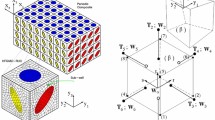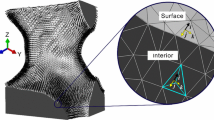Abstract
A 3D anisotropic micropolar continuum model of vertebral trabecular bone is presently developed accounting for the influence of microstructure-related scale effects on the macroscopic effective properties. Vertebral trabecular bone is modeled as a cellular material with an idealized periodic structure made of open 3D cells. The micromechanical approach relies on the discrete homogenization technique considering lattice microrotations as additional degrees of freedom at the microscale. The effective elastic properties of 3D lattices made of articulated beams taking into account axial, transverse shearing, flexural, and torsional deformations of the cell struts are derived as closed form expressions of the geometrical and mechanical microparameters. The scaling laws of the effective moduli versus density are determined in situations of low and high effective densities to assess the impact of the transverse shear deformation. The classical and micropolar effective moduli and the internal flexural and torsional lengths are identified versus the same microparameters. A finite element model of the local architecture of the trabeculae gives values of the effective moduli that are in satisfactory agreement with the homogenized moduli.


















Similar content being viewed by others
References
Arthur Moore TL, Gibson LJ (2001) Modeling modulus reduction in bovine trabecular bone damaged in compression. J Biomech Eng 123:613–622
Ashman RB, Turner CH, Cowin SC (1986) Ultrasonic technique for the measurement of the structural elastic modulus of cancellous bone. Trans Orthop Res Soc 43
Ashman RB, Rho JY, Turner CH (1989) Anatomical variation of orthotropic elastic moduli of the proximal tibia. J Biomech 22:895–900
Banse X, Sims TJ, Bailey AJ (2002) Mechanical properties of adult vertebral cancellous bone: correlation with collagen intermolecular cross-links. J Bone Miner Res 17(9):1621–1628
Bowman SM et al (1998) Creep contributes to the fatigue behavior of bovine trabecular bone. J Biomech Eng 120:647–654
Caillerie D, Mourad A, Raoult A (2006) Discrete homogenization in graphene sheet modeling. J Elast 84:33–68
Cendre E, Mitton D, Roux JP, Arlot ME, Duboeuf F, Burt-Pichat B, Rumelhart C, Peix G, Meunier PJ (1999) High-resolution computed tomography for architectural characterization of human lumbar cancellous bone: relationships with histomorphometry and biomechanics. Osteoporos Int 10:353–360
Cowin SC (1970) An incorrect inequality in micropolar elasticity theory. Z Angew Math Phys 21(3):494–497
Dagan D, Be’ery M, Gefen A (2004) Single-trabecula building block for large-scale finite element models of cancellous bone. Med Biol Eng Comput 42(4):549–556
Diamant I, Shahar R, Gefen A (2005) How to select the elastic modulus for cancellous bone in patient-specific continuum models of the spine. Med Biol Eng Comput 43(4):465–472
Diamant I, Shahar R, Masharawi Y, Gefen A (2007) A method for patient-specific evaluation of vertebral cancellous bone strength: in vitro validation. Clin Biomech 22:282–291
Dickerson DA, Sander EA, Nauman EA (2008) Modeling the mechanical consequences of vibratory loading in the vertebral body: microscale effects. Biomech Model Mechanobiol 7:191–202
Dos Reis F, Ganghoffer JF (2012) Equivalent mechanical properties of auxetic lattices from discrete homogenization. Comput Mater Sci 51:314–321
Eringen AC (1999) Microcontinuum field theories 1: foundations and solids. Springer, New York
Fatemi J, van Keulen F, Onck PR (2002) Generalized continuum theories: application to stress analysis in bone. Meccanica 37:385–396
Fatemi J, Onck PR, Poort G, van Keulen F (2003) Cosserat moduli of anisotropic cancellous bone: a micromechanical analysis. J Phys IV France 105:273–280
Fenech CM, Keaveny TM (1999) A cellular solid criterion for predicting the axial-shear failure properties of bovine trabecular bone. J Biomech Eng 121:414–422
Ford CM, Keaveny TM (1996) The dependence of shear failure properties of trabecular bone on apparent density and trabecular orientation. J Biomech 29:1309
Gefen A, Portnoy S, Diamant S (2008) Inhomogeneity of tissue-level strain distributions in individual trabeculae: mathematical model studies of normal and osteoporosis cases. Med Eng Phys 30:624–630
Gibson LJ (1985) The mechanical behavior of cancellous bone. J Biomech 18:317–328
Gibson LJ (2005) Biomechanics of cellular solids. J Biomech 38:377–399
Gibson LJ, Ashby MF (1997) Cellular solids: structures and properties, 2nd edn. Cambridge University Press, Cambridge
Gitman IM, Askes H, Kuhl K, Aifantis EC (2010) Stress concentrations in fractured compact bone simulated with a special class of anisotropic gradient elasticity. Int J Solids Struct 47:1099–1107
Guo XE, Kim CH (2002) Mechanical consequence of trabecular bone loss and its treatment: a three-dimensional model simulation. Bone 30(2):404–411
Harrison NM, McDonnell PF, O’Mahoney DC, Kennedy OD, O’Brien FJ, McHugh PE (2008) Heterogeneous linear elastic trabecular bone modelling using micro-CT attenuation data and experimentally measured heterogeneous tissue properties. J Biomech 41:2589–2596
Havill LM, Allen MR, Bredbenner TL, Burr DB, Nicolella DP, Turner CH, Warren DM, Mahaney MC (2010) Heritability of lumbar trabecular bone mechanical properties in baboons. Bone 46:835–840
Hellmich C, Ulm FJ, Dormieux L (2004) Can the diverse elastic properties of trabecular and cortical bone be attributed to only a few tissue-independent phase properties and their interactions? Arguments from a multiscale approach. Biomech Model Mechanobiol 2:219–238
Hou FJ, Lang SM, Hoshaw SJ, Reimann DA, Fyhriee DP (1998) Human vertebral body apparent and hard tissue stiffness. J Biomech 31(11):1009–1015
Hu JH, Ding M, Søballe K, Bechtold JE, Danielsen CC, Day JS, Hvid I (2002) Effects of short-term alendronate treatment on the three-dimensional microstructural, physical, and mechanical properties of dog trabecular bone. Bone 31(5):591–597
Jeong J, Abid-Ramezani H, Al-Mukhtar M (2008) Numerical simulation of elastic linear micropolar media based on the pore space length scale assumption. Strength Mater 40:425–438
Jorgensen CS, Kundu T (2002) Measurement of material elastic constants of trabecular bone: a micromechanical analytic study using a 1 GHz acoustic microscope. J Orthop Res 20:151–158
Kasra M, Grynpas MD (2007) On shear properties of trabecular bone under torsional loading: effects of bone marrow and strain rate. J Biomech 40:2898–2903
Keaveny TM (1997) Mechanistic approaches to analysis of trabecular bone. Forma 12:267–275
Keaveny TM, Pinilla TP, Crawford RP, Kopperdahl DL, Lou A (1997) Systematic and random errors in compression testing of trabecular bone. J Orthop Res 15(1):101–110
Keller TS, Hansson TH, Abram AC, Spengler DM, Panjabi MM (1989) Regional variations in the compressive properties of lumbar vertebral trabeculae: effects of disc degeneration. Spine 14:1012–1019
Kim HS, Al-Hassani STS (2001) A morphological elastic model of general hexagonal columnar structures. Int J Mech Sci 43:1027–1060
Kim HS, Al-Hassani STS (2002) A morphological model of vertebral trabecular bone. J Biomech 35:1101–1114
Koiter WT (1964) Couple stress in the theory of elasticity. In: Proceeding of the Koninklijke Nederland Akademie van Wettenschappen, vol B-67, pp 17–44
Kopperdahl DL, Keaveny TM (1998) Yield strain behavior of trabecular bone. J Biomech 31:601–608
Kopperdahl DL, Morgan EF, Keaveny TM (2002) Quantitative computed tomography estimates of the mechanical properties of human vertebral trabecular bone. J Orthop Res 20:801–805
Lakes R (1993a) Materials with structural hierarchy. Nature 361:511–515
Lakes RS (1993b) Strongly Cosserat elastic lattice and foam materials for enhanced toughness. Cell Polym 12:17
Lakes R, Nakamura S, Behiri J, Bonfield W (1990) Fracture mechanics of bone with short cracks. J Biomech 23:967–975
Lakes R (1995) Experimental methods for study of Cosserat elastic solids and other generalized elastic continua. In: Muhlhaus H-B (ed) Continuum models for materials with microstructure. Wiley, New York, pp 1–22
Lai WM, Rubin D, Krempl E (1993) Introduction to continuum mechanics. Pergamon Press, New York
Liu XS, Zhang XH, Guo XE (2009) Contributions of trabecular rods of various orientations in determining the elastic properties of human vertebral trabecular bone. Bone 45:158–163
Lorenzetti SR (2006) New method to determine the Young’s modulus of single trabeculae. Ph.D. Thesis, Rutgers University, Swiss Federal Institute of Technology
Miller Z, Fuchs MB (2005) Effect of trabecular curvature on the stiffness of trabecular bone. J Biomech 38:1855–1864
Morgan EF, Keaveny TM (2001) Dependence of yield strain of human trabecular bone on anatomic site. J Biomech 34:569–577
Morgan EF, Bayraktar HH, Keaveny TM (2003) Trabecular bone modulus-density relationships depend on anatomic site. J Biomech 36:897–904
Niebur GL, Yuen JC, Hsia AC, Keaveny TM (1999) Convergence behavior of high-resolution finite element models of trabecular bone. J Biomech Eng 121(6):629–635
Overaker DW (1997) Micromechanical modeling of open cell structures with application in finite element analysis of vertebral body mechanics. Ph.D. Thesis, Rutgers University
Park HC, Lakes RS (1987) Torsion of a micropolar elastic prism of square cross section. Int J Solids Struct 23:485–503
Pradel F (1998) Homogénéisation des milieux discrets périodiques orientés. Une application aux mousses. Dissertation, l’Ecole Nationale des Ponts et Chaussées, Champs-sur-Marne
Pradel F, Sab K (1998) Cosserat modelling of elastic periodic lattice structures. C R Acad Sci Paris Ser IIb 326:699–704
Rajan K (1985) Linear elastic properties of trabecular bone: a cellular solid approach. J Mater Sci Lett 4:609–611
Rho JY, Hobatho MC, Ashman RB (1995) Relations of mechanical properties to density and CT numbers in human bone. Med Eng Phys 17:347–355
Sab K (1996) Déformations microscopiques et macroscopiques dans un assemblage dense de particules rigides. C R Acad Sci Paris Ser IIb 322:715–721
Sander EA, Shimko DA, Dee KC, Nauman EA (2003) Examination of continuum and micro-structural properties of human vertebral cancellous bone using combined cellular solid models. Biomech Model Mechanobiol 2:97–107
Shmoylova E, Potapenko S, Rothenburg L (2007) Stress distribution around a crack in plane micropolar elasticity. J Elast 86:19–39
Silva M, Gibson L (1997) Modeling the mechanical behavior of vertebral trabecular bone: effects of age-related changes in microstructure. Bone 21:191–199
Tanaka M, Adachi T (1999) Lattice continuum model for bone remodeling considering microstructural optimality of trabecular architecture. In: Pedersen P, Bendsoe MP (eds) IUTAM symposium on synthesis in bio solid mechanics. Kluwer Academic Publishers, The Netherlands, pp 43–54
Taylor M, Cotton J, Zioupos P (2002) Finite element simulation of the fatigue behaviour of cancellous bone. Meccanica 37:419–429
Tollenaere H, Caillerie D (1998) Continuous modeling of lattice structures by homogenization. Adv Eng Softw 29:699–705
Vajjhala S, Kraynik AM, Gibson LJ (2000) A cellular solid model for modulus reduction due to resorption of trabecular bone. J Biomed Eng 122:511–515
van Rietbergen B, Weinans H, Huiskes R, Odgaard A (1995) A new method to determine trabecular bone elastic properties and loading using micromechanical finite-element models. J Biomech 28:69–81
van Eijden TMGJ, van Ruijven LJ, Giesen EBW (2004) Bone tissue stiffness in the mandibular condyle is dependent on the direction and density of the cancellous structure. Calcif Tissue Int 75:502–508
Wang X, Guyette J, Liu X, Roeder RK, Niebur GL (2005) Axial-shear interaction effects on microdamage in bovine tibial trabecular bone. Eur J Morphol 42:61–70
Wolframa U, Wilke H-J, Zysset PK (2010) Valid \(\mu \) finite element models of vertebral trabecular bone can be obtained using tissue properties measured with nanoindentation under wet conditions. J Biomech 43:1731–1737
Xia Z, Zhang Y, Ellyin F (2003) A unified periodical boundary conditions for representative volume elements of composites and applications. Int J Solids Struct 40:1907–1921
Yang JFC, Lakes RS (1981) Transient study of couple stress effects in compact bone: torsion. J Biomech Eng 103:275–279
Yoo A, Jasiuk I (2006) Couple-stress moduli of a trabecular bone idealized as a 3D periodic cellular network. J Biomech 39:2241–2252
Acknowledgments
The authors are grateful for technical recommendations and scientific support provided by Dr. Y. Koutsawa from CRP Henri Tudor.
Author information
Authors and Affiliations
Corresponding author
Appendix: homogenized elastic rigidities of the 3D hexagonal orthotropic lattice
Appendix: homogenized elastic rigidities of the 3D hexagonal orthotropic lattice
The elastic constants in the homogenized stiffness matrix express versus the geometrical and micromechanical parameters of the unit cell as follows:
Rights and permissions
About this article
Cite this article
Goda, I., Assidi, M. & Ganghoffer, J.F. A 3D elastic micropolar model of vertebral trabecular bone from lattice homogenization of the bone microstructure. Biomech Model Mechanobiol 13, 53–83 (2014). https://doi.org/10.1007/s10237-013-0486-z
Received:
Accepted:
Published:
Issue Date:
DOI: https://doi.org/10.1007/s10237-013-0486-z




